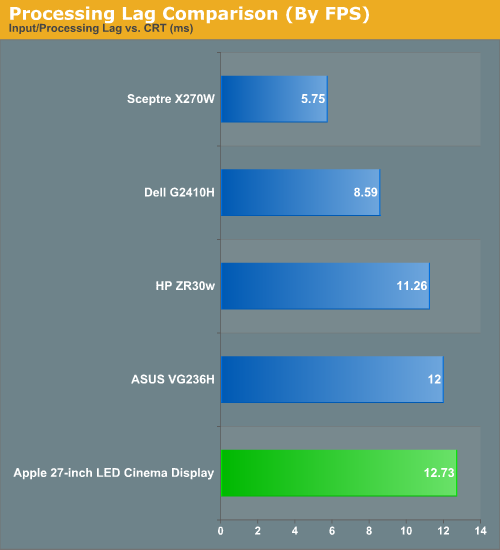Apple 27-inch LED Cinema Display Review
by Anand Lal Shimpi on September 28, 2010 12:15 AM EST- Posted in
- Displays
- Mac
- Apple
- Cinema Display
Processing and Input Latency
Processing and display lag are very important for gamers, and it’s most often nebulously reported if at all. We’ve discussed this in previous display reviews, but what matters most is how the display acts in real world testing. I’ve been doing previous tests by comparing LCDs with first a 17” CRT.
To measure input and processing lag we're sending the same frame data to both the LCD tested and a 17" CRT in parallel (using our GeForce GT 120). Using our camera set to a high shutter speed we grab shots of 3DMark 03's Wings of Fury benchmark which conveniently displays frame rate and frame count.

We compare the two to determine input lag, assuming the CRT over VGA exhibits minimal lag:

The 27's input lag is nothing to write home about. It's not slow enough to cause any problems gaming in my experience but it's not fast enough to set any records either. Ghosting was also typical of other displays, I captured one frame of ghosting:











93 Comments
View All Comments
Razorjackman - Tuesday, September 28, 2010 - link
Why are all the displays from 24" and below relatively inexpensive, while the +27" seem to be disproportionately expensive?I'm still using a HannsG 28" from 2 years ago for $400.00. I expected to get larger or denser for less by now.
Does Moores Law apply to monitors?
B3an - Tuesday, September 28, 2010 - link
Because theres loads of cheap crappy TN panels in displays 24" and under, which i'd never even consider buying. Most old cheap CRT monitors would have better colours.When you move to 27" and especially 30" you start getting some quality IPS panels.
You dont just get a larger display with more pixels, you get a vastly better image too.
B3an - Tuesday, September 28, 2010 - link
... You also get better viewing angles as well.Alexstarfire - Tuesday, September 28, 2010 - link
True, but they were saying even the IPS panels for the 24" were $539 and up. Says so on the first page. A near doubling in price for an extra 3 inches isn't very compelling. Though, I don't know if the two 27" monitors they talk about are the cheapest for 27" monitors.hughlle - Tuesday, September 28, 2010 - link
Partly to do with who they are aimed at i guess. A lot of the folk opting for these high end 30" displays as opposed to just whacking an LCD tv on their desk, are using it for high end audio, graphic design etc, professional use you might say, so can be expected to spend the premium.TegiriNenashi - Tuesday, September 28, 2010 - link
I'd suggest there is a category between high end 30" and mainstream 24". There is something wrong with the market when 24" TN is <$250 and 30" IPS is >$1000 and there is nothing in-between.juncture - Tuesday, December 14, 2010 - link
These people also forgot to mention the HUGE difference being the resolution.... Try to find a 24" that has the same resolution as the $1000+ 27"-30". How was this not mentioned in this argument?plonk420 - Tuesday, September 28, 2010 - link
seconded .. it's either crap dirt cheap TNs for me ... or IPS (but preferrably oLED). i hope i never spend more than $140 on a TN again...(posting from a dying CRT ... with TN+Dell *VA as secondary)
plonk420 - Tuesday, September 28, 2010 - link
seconded @B3anTargon - Tuesday, September 28, 2010 - link
It has to do with yields and the production costs. It is far easier to make a PERFECT four inch display than an eight inch display, just because there is a smaller chance of dead or stuck pixels. As the size of the screen goes up, it just becomes that much harder to make a display without any problems.As time has gone on, with the older technologies, it has gotten easier to make larger panels that don't have problems, but now we are seeing newer technologies that raise the difficulty again.
When you got that 28 inch display, was that a 1080p or 1080i, or 720p? These days, the LED technologies are where a lot of the focus is. Then you have the move from 60Hz to 120Hz to 240Hz. 3D is also creeping in as something that will push costs up.
Two years ago, the cost of a 23 inch panel was MUCH higher than it is today, and you are seeing displays that could not do 1080p going away. So, now that 1080p is the norm for flat panel displays, the question is when better displays will become the norm on the desktop.
We also have a problem with what integrated video can handle. The Radeon 3300 integrated video for example will handle 1280x1024 decently, but starts to have a bit of a problem at 1920x1080 when it comes to basic games and such. So, before the mainstream consumer can make decent use of higher resolution displays, the base level for GPUs needs to go up by a bit more to make the experience properly "smooth".
Remember, prices come down when the manufacturers can expect high enough sales volumes to allow the drop in price to still provide a good profit. So, how many 1920x1200 displays would sell at $300 compared to 1920x1080 displays selling at $210? How about going up from there, would the general public pay for a higher quality display if their computer couldn't push the pixels well enough at the higher resolutions? Even on the gamer front, would you be willing to pay $400 for a 23 inch display with a higher resolution since the higher resolution means lower framerates?